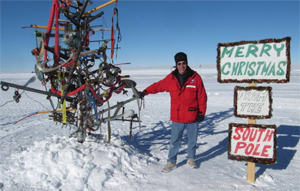
Home for the holidays--at South Pole Station
Editor's note: With support from the National Science Foundation, University of Delaware researchers have been working on the IceCube neutrino telescope in one of the iciest, coldest, most austere places on the planet: South Pole, Antarctica. Thomas Gaisser, director of UD's Bartol Research Institute, James Roth, and Stoyan Stoyanov blogged from South Pole Station for the past few weeks and are now back at UD, while researcher Len Shulman arrived in mid-December to continue the mission.
Their Antarctic blogs will appear on UDaily and on the Wilmington News Journal’s Delaware Online Web site through a partnership between UD and the newspaper.

3:47 p.m., Jan. 9, 2008--Being away from home during the holidays is always hard, and this is especially true at the literal end of the earth, the South Pole. Here, satellite connectivity for Internet and domestic phone calls is available only eight hours each day. This community of 250 people, living at 10,600 feet on the world's largest ice cap, braving -20 degree summer temperatures, has developed a unique camaraderie that may be as friendly and comforting as this location is harsh.
Our year-end celebrations begin with Christmas Eve dinner, a semi-casual affair held in the galley, with appetizers served in the hallway to the strains of our local troubadours.
Blinders are placed in all the galley windows to block the dazzling 24-hour sun, thus simulating a winter's evening meal back home. Speeches and toasts are made, and we quickly get down to a delicious lobster and beef Wellington meal. This is the 51st consecutive Christmas dinner to be held at the South Pole since the first Pole station was established in 1956.
|
|
On Dec. 25, the famous Race Around the World is held, during which nearly half the station runs, walks, skis, drives or rides in a wild one-mile circuit around the Earth's southern axis of rotation.
Another time-honored tradition at the South Pole is the placement of the new marker that locates the Earth's southern axis of rotation. This point moves about 30 feet every year because the two-mile ice cap is sliding toward the ocean.
After the festivities, it's back to work. Twelve-hour workdays and six-day workweeks are not unusual since the season lasts only 100 days every year, and we must hurry to accomplish our goals before the sun sets again for six months.
The biggest science effort at the South Pole is IceCube. This project is designed to instrument a cubic kilometer of the two-mile-thick ice below the station with an array of 4,800 optical detectors. When finished, this array will look for the illusive neutrinos that enter the north pole of the earth, pass entirely through our planet, and leave faint trails of light deep in the ice as they travel upwards through our feet at the South Pole.
The central part of this project is the installation of the Digital Optical Modules (DOMs) that will actually see the light signals produced by the interactions of the neutrino particles. This season, the project's goal is to install 18 strings of 60 detectors each, and I was privileged to be a team member during the deployment of four strings.
First, a hot-water drill is used to melt a long hole in the ice to a depth of 2,400 meters. Then, after the drill is withdrawn, the end of the connection cable is passed over the top of the deployment tower, and five 100-pound weights are attached.
The weights pull the cable into the hole, and thus begins the eight-hour process of threading the cable down the melted ice hole and attaching 60 DOMs sequentially in a delicate ballet with seven other people before the water refreezes.
I leave South Pole on Thursday [Jan. 10]. It's been an exciting and rewarding experience. Even though this is my 19th time on the ice, the spirit of Antarctica continues to capture my imagination, and I am grateful for the opportunity to work at the End of the Earth.
Article by Leonard Shulman

